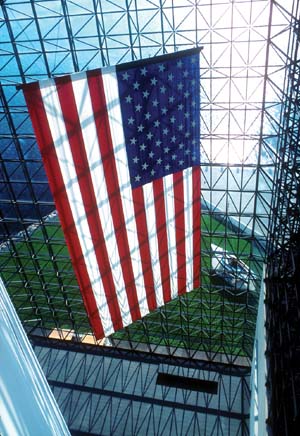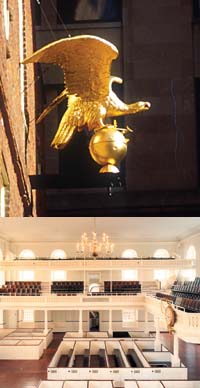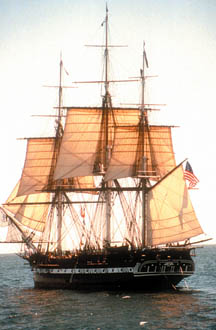
 IDYLL OF AMERICA—The Stars and Stripes hangs proudly at the John F. Kennedy Library and Museum on Columbia Point. |
by Andrew King
Suddenly, on the tragic morning of September 11, 2001, America—its people and its pillars of freedom—were blindsided with the shocking reality of an unstable world. Not since Pearl Harbor had an enemy penetrated our sovereign borders; not since the tumultuous World Wars of the 20th century have the citizens of this country felt such pride and solidarity. The roots of this feisty spirit can be traced back to Boston’s colonial history-makers, such as the Sons of Liberty, who led a successful fight for independence against the British Empire during the American Revolution, earning Boston its reputation as the “Cradle of Liberty.” Though it’s sometimes characterized as a city living in the past, Beantown’s storied legacies and landmarks remain sacred emblems of freedom, and now stand as beacons in a new age of patriotism. Here’s our survey of people and places that have made Boston proud.
Old State House
Corner of Washington and State streets, 617-720-3290
This building, the oldest surviving public structure in the city, was the nucleus of what would become the body politic of America. The fervor must have rumbled through its brick walls during the late 1700s, when the Old State House was home to both the British Council Chamber of the Royal Governor, as well as the homegrown, colonial Massachusetts Assembly. It was a meeting place where colonial leaders such as James Otis spoke about economics and community, and later protested unfair laws imposed by the British. Just outside its doors, on March 5, 1770, shots were fired into an angry crowd, and the Boston Massacre sowed the seeds of a Revolution. And so followed the Old State House’s eternal moment in American history on July 18, 1776, when the Declaration of Independence was first read from its balcony.
 CORRIDORS OF FREEDOM—A golden eagle sits atop its perch at the Old State House (top); the Old South Meeting House has hosted countless orators in its long history (above). |
310 Washington St., 617-482-6439
As the Old State House symbolizes representative government, the Old South Meeting House recalls our treasured First Amendment: Freedom of Speech. Built in 1729 as a Puritan meeting house and religious congregation, The Old South grew into a public symposium for the most inflamed sentiments of a country in germination. Voices of protest and praise have hailed this minimalist building from the colonial days up through today. But the seminal debate was the one that took place on December 16, 1776, as 5,000 protesters stormed the Old South to debate the ill-fated tea tax, which led to the Boston Tea Party, later igniting the American Revolution.
Boston Tea Party Ship & Museum
Congress Street Bridge, 617-338-1773
Okay, so this is actually a replica ship and it’s closed for the rest of the season due to fire damage. But the Boston Tea Party Ship & Museum is an indelible token of the patriotic zeal that fueled “the single most important event leading up to the American Revolution.” With the chants of “no taxation without representation” fresh in their minds, a group of colonists, led by the Sons of Liberty, snuck aboard a British ship and flung 342 chests of tea into the harbor at Griffin’s Wharf. The rest, as they say, is history.
Faneuil Hall
Merchants Row and Faneuil Hall Square, 617-227-1638
Dubbed the “Cradle of Liberty,” Faneuil Hall’s colonial brick edifice and white-washed window frames incorporate Freedom in many forms. What was constructed in 1742 as an open forum and meeting hall, and thrived as a center of discourse and debate, is now the city’s most celebrated hub of commerce, arts and culture. Like the Old South Meeting House, Faneuil Hall was once the setting for colonial protestations that ignited the American Revolution. Its speakers have ranged from Samuel Adams to current Massachusetts Senator Edward M. Kennedy. Today, Faneuil Hall also houses a military museum.
Bunker Hill Monument & Museum
Breed’s Hill, Charlestown, 617-424-5641
This 221-foot granite obelisk marks the Boston skyline with patriotic prominence (and its likeness now caps-off the soon-to-be-finished Leonard P. Zakim Bunker Hill Bridge).
It commemorates the first major battle of the Revolutionary War, the 1775 Battle of Bunker Hill (which actually took place on Breed’s Hill), in which a small but determined army of colonists inflicted devastating losses on the British forces. William Prescott’s order “Don’t fire until you see the whites of their eyes!” came to represent the ideals of efficiency and resolve that the U.S. military still aspires to today.
 GLORY DAYS—The U.S.S. Constitution, affectionately known as “Old Ironsides,” is an enduring symbol of America’s patriotic past. |
Charlestown Navy Yard, 617-242-5670
“Huzzah! Her sides are made of iron!” shouted out a crew of
U.S. seamen in the Carribean. American military prowess initially earned its reputation in part because of “Old Ironsides,” the nickname ascribed to the U.S.S. Constitution after she withstood cannonball fire from HMS Guerriere during the War of 1812. Apparently, the giant balls simply bounced off her hull, inspiring Oliver Wendell Holmes, Sr.’s poem “Old Ironsides,” which he penned in an attempt to save the ship from the scrap heap. She was nearly scrapped again in the mid 20th century, but was again spared by a rise in patriotism. The Constitution is the oldest commissioned warship in the world and remains a national symbol of military resilience.
John F. Kennedy Library & Museum
Off Morrissey Boulevard, Next to UMass-Boston, 617-929-4523
Antithetical to most Boston landmarks in its architectural appearance, the John F. Kennedy Library & Museum nevertheless embodies the same patriotic ideals as the sites along the Freedom Trail. Designed by
renowned architect I.M. Pei, the Kennedy Library’s expansive, streamlined presence overlooking the shores of Boston Harbor honors the legacy of former President John F. Kennedy, his brother Robert Kennedy and the late Jacqueline Kennedy Onassis. As one of the most popular modern-day U.S. presidents, J.F.K. inspired a new generation of patriots. And the Kennedy Library itself, with dozens of exhibits, videos and political discussion forums, is a living inspiration to continue the pursuits that J.F.K. and others left behind.
Pop Goes the Fourth!
The Hatch Shell, Charles River Esplanade, July 4
The spectacle of fireworks and symphonic thunder that decorate the Esplanade each year could be considered America’s official Fourth of July celebration. The nationally televised event features Keith Lockhart (with special celebrity guests) and the Boston Pops Orchestra’s annual performance of Tchaikovsky’s 1812 Overture, followed by a brilliant fireworks display overhead. It is the annual tribute to the independence that was fought for so vigorously right here in Boston 225 years ago.

back to homepage